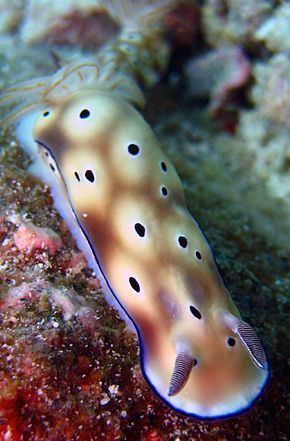Superfamily Doridoidea | Scientific name Risbecia tryoni Rank Species | |
 | ||
Similar Risbecia, Hypselodoris, Glossodoris, Doriprismatica atromarginata, Goniobranchus kuniei | ||
Nudis 4u ardeadoris egretta goniobranchus kuniei halgedera batangas hypselodoris tryoni
Hypselodoris tryoni is a species of sea slug, a dorid nudibranch, a marine gastropod mollusk in the family Chromodorididae.
Contents
- Nudis 4u ardeadoris egretta goniobranchus kuniei halgedera batangas hypselodoris tryoni
- Hypselodoris tryoni fr ambon bay
- Taxonomic history
- Distribution
- Description
- Ecology
- References
Hypselodoris tryoni fr ambon bay
Taxonomic history
The decision to include Risbecia species within the genus Hypselodoris was made on the basis of a molecular (DNA) study which showed that Risbecia species are a clade inside the genus Hypselodoris as currently constituted.
Distribution
This species was described from the Society Islands. It is reported to occur widely in the tropical Western Pacific Ocean from Australia to the Philippines.
Description
Hypselodoris tryoni has a brown body and white foot. The body and upper dorsum are covered in purple spots ringed with white or light-brown. The gills are typically translucent white or light-brown and the rhinophores are brown to dark-brown and covered in circular white lines. It has a thin blue or purple line on the mantle edge. There is some colour variation between individuals.
Hypselodoris tryoni is similar in appearance to Goniobranchus geminus, Goniobranchus kuniei and Goniobranchus leopardus, although it lacks the wide purple mantle edge line present in those species.
Sea slugs such as Hypselodoris tryoni, are known to exhibit trailing behaviour where up to four animals will follow one another very closely, often touching. It is not known what causes this behaviour.
Hypselodoris tryoni reaches at least 60 mm in length.
Ecology
Like many slugs in the family Chromodorididae, Risbecia tryoni feeds on sponges and have been seen feeding on sponges from the genus Dysidea. When feeding they are sometimes accompanied by a species of shrimp, Periclimenes imperator, in an apparent form of commensalism.
